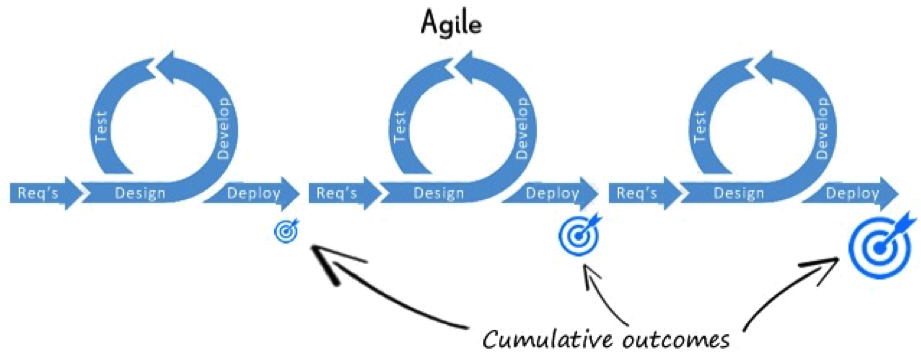The traditional methodology for enhancements
For many years, the SAP functional enhancement process has used the traditional waterfall methodology. That is, a requirement is defined, a solution is designed, implemented, tested, and deployed in production. The entire process may take weeks or months, depending on the complexity of the requirement. Process quality is usually measured according to two criteria: 1) if the execution went as planned, in terms of effort and deadlines, and 2) if the final product is error-free.


The problems of traditional methodology
This methodology has two major deficiencies. Namely:
- The time elapsed between the moment a business demand appears and the moment a product to support it is delivered is long. This undermines the agility of the company, business areas feel dissatisfied, and friction emerges between the business and IT areas. Emergency implementations that do not follow any quality process are often used to solve requirements promptly.
- The interaction and collaboration between the business and IT areas is restricted to the initial phases of requirement definition, overall solution design, and final testing. Most of the time, the rest of the process takes place only within the IT area, without the involvement of business areas. Therefore, to ensure the deliverable’s quality much time and effort must be spent during the initial stage, with thorough surveys, detailed designs, validations, etc., and the same occurs during the testing phase.
The glitches of outsourcing this process
Companies that outsource SAP enhancement processes simply subcontract external consultancy to execute most of the tasks in the process, especially those that do not interact with the business. So, even though it appears they are outsourcing their enhancement process, in practice they are just out-tasking consulting services for the implementation. In an out-tasking relationship, the product delivered by the external provider has no relation to the business goals of the client company. Therefore, these contracts are reduced to hiring a monthly consultancy pack of X hours, at a Y fee. The provider’s obligations are limited to delivering the enhancement in the committed deadlines and, only occasionally, to comply with a certain level of quality in the deliverables.
This type of outsourcing induces the supplier to offer low prices, use cheap resources, and to extend implementation times. As a result, the client company obtains a poor-quality product, which in appearance is cheaper, even though the final result is always more costly.
The agile methodology
Agile methodologies have proven to be quite successful in software development processes. SAP has partially incorporated this type of methodologies in the latest ASAP versions, to accelerate the implementation of solutions.
The agile methodology is oriented towards the following main objectives:
- Reduce the time needed to generate deliverables for the business.
- Ensure that the deliverables satisfy real business needs.

To achieve these objectives, unlike traditional methodologies, the process requires a collaborative job between the business or operational area and the development or IT area (or external IT provider). This is why in some cases we speak of DevOps (Development/Operations) methodologies, to underline this kind of collaborative work.
One of the ways of working is to form a collaborative team, or Scrum, made up of business or operation people or users on the one hand, and by developers or implementers or consultants on the other. This team receives a business requirement and quickly defines a minimal deliverable that may be implemented in a short period of time, one or two weeks, called a Sprint. The idea is that this deliverable will be the first version of a cumulative or incremental deliverable, which will gradually improve the product put into production, in a repetitive cycle of deliveries, operation, monitoring, and improvements.
Advantages of the agile methodology
The following benefits are attained with this method:
- The business obtains tangible results in a short period of time. It confers agility to the process and to the business, making adaptation to the digital age possible.
- Results are always oriented towards the business’ goals, and not towards meeting schedules and avoiding mistakes. It allows IT areas to be in sync with the business areas.
- Long initial phases of surveys, diagnostic, design, etc., are not necessary. Timeframes, costs, and risks are reduced.
- The methodology is especially useful in situations where the problem, or diagnostic, or final solution, are not fully defined since it makes it possible to incorporate external consulting services quickly.
- It allows the implementation of result-oriented external services. A true outsourcing: a business-oriented service that encourages the provider to engage with the client and to use its best resources.
The implementation of this methodology requires specialized consultancy, and organizational changes within the client company. At Novis we have all the necessary elements to guide our clients in this paradigm shift, and in this way deliver SAP functional enhancement services of a new kind.
Feedback/discussion with the author: Glen Canessa, Presales Manager at Novis.
For more information about our services, we invite the SAP community to contact us via the contact form.